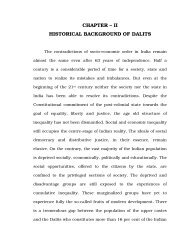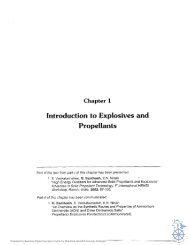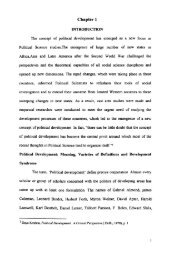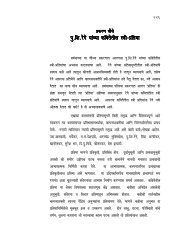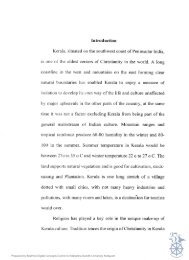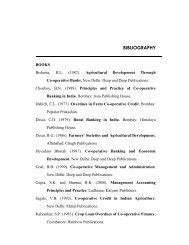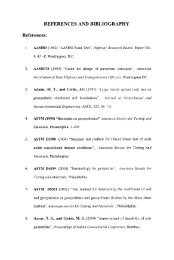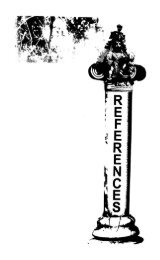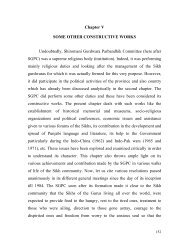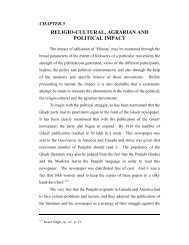Chapter 2 REVIEW OF LITERATURE - Shodhganga@INFLIBNET ...
Chapter 2 REVIEW OF LITERATURE - Shodhganga@INFLIBNET ...
Chapter 2 REVIEW OF LITERATURE - Shodhganga@INFLIBNET ...
You also want an ePaper? Increase the reach of your titles
YUMPU automatically turns print PDFs into web optimized ePapers that Google loves.
<strong>Chapter</strong> 2<br />
<strong>REVIEW</strong> <strong>OF</strong> <strong>LITERATURE</strong><br />
Literature search is a vital part of all research. There are several benefits of such a<br />
search. It provides a source of research ideas, gives an orientation to what is already<br />
known, helps to develop a conceptual framework, indicates as assessment of<br />
feasibility and provides information on the research approach to be used.<br />
The aim of the study was to document the efforts now in progress i.e. Open access<br />
movement with sharp focus on Institutional repositories, which is one of the important<br />
means of achieving open access. The main objective of this study was to identify the<br />
wide range of practices involved in developing and managing an institutional<br />
repository and to investigate knowledge, practice and opinions about the IR among<br />
the users of the institutions having institutional repositories.<br />
The present study examined institutional repositories developed in India from two<br />
perspectives: IR Development and Management; and Users of institutions having IR.<br />
Relevant literature on both aspects were consulted. Over the past five years, the<br />
implementation of IRs has been growing rapidly and the publications on IRs have<br />
flourished accordingly. Therefore this chapter is divided into three sections namely IR<br />
Development and Management, Users of institutions having IR and Institutional<br />
repository initiatives in India.<br />
The section on IR Development and Management begins with Scholarly<br />
communication and then moves on to the specific areas of Institutional repositories.<br />
While the section on Users of institutions having IR begins with general studies on<br />
authors and then sheds light on specific areas such as Experience of IR, Contribution<br />
to IR and Opinion about IR.
2.1 IR Development and Management<br />
<strong>Chapter</strong> 2: Review of Literature<br />
Literature on IR Development and Management could be largely divided into studies<br />
as follows:<br />
2.1.1. Scholarly communication<br />
2.1.2. Open access movement<br />
2.1.3. Concept of Institutional Repository<br />
2.1.4. Issues of IRs / Basic components of IR<br />
a) Timeline<br />
b) Exploratory activities<br />
c) Anticipated benefits<br />
d) Management<br />
e) Contributors<br />
f) IR System / Software<br />
g) Number, types and rate of growth of digital documents<br />
h) Inhibiting factors<br />
2.1.1 Scholarly Communication<br />
A few studies specifically related to scholarly communication were located. The<br />
significant article by Van de Sompel, Payette, Erickson, Lagoze, and Warner (2004)<br />
explored characteristics of the established scholarly communication system, and<br />
observed emerging trends after studying changing nature of research. They tried to<br />
distill some core characteristics of a future scholarly communication system.<br />
Pöschl (2004) discussed the failure of traditional journal publishing and peer review<br />
to provide efficient scientific exchange and quality assurance in today‘s highly<br />
diverse world of science. He also proposed the most promising way to improve<br />
matters is a two-stage (or multi-stage) publication processes with interactive peer<br />
review and public discussion in new and traditional scientific journals.<br />
Several studies explained how an IR would be a new strategy for facilitating changes<br />
in electronic scholarly communication (Chan, 2004; Crow, 2002; Lynch, 2003;<br />
Shearer, 2003).<br />
25
2.1.2 Open Access Movement<br />
<strong>Chapter</strong> 2: Review of Literature<br />
Awre (2003) described the advent and development of the open access movement. He<br />
also argued that this movement poses a challenge to traditional journal publishing like<br />
no other before and it is inevitable that current practice in publishing and purchasing<br />
will be affected. Buckholtz, Dekeyser, Hagemann, Krichel, and Van de Sompel<br />
(2003) gave the historical overview of Open Access Movement. The paper described<br />
how the effects of open Access (OA) are being addressed, and what OA will mean for<br />
publishers, librarians, and intermediaries.<br />
Pellizari (2003) examined strengths and weaknesses of the Open Access strategy in<br />
general and, more specifically, of the Open Archives Initiative, discussing<br />
experiences, criticisms and barriers. Peter Suber (2004b) gave a brief overview of<br />
Open Access especially for those who are new to the concept. Association of<br />
Research Libraries (2003) in their article highlighted the key points to consider in<br />
thinking about and discussing open access. This article gave examples of open access<br />
implementation and provided sources for more information.<br />
Davis et al. (2004) examined different aspects of the Open Access and offered<br />
recommendations for Cornell University Library's involvement in the arena of Open<br />
Access publishing. They concluded that the Open Access and subscription models can<br />
coexist and are in fact likely to do so for the foreseeable future. Peter Suber (2004a) in<br />
his report gave a brief overview of significant happenings of Open access movement<br />
of 2003.<br />
Meyers (2004) in her report highlighted the critical events that have taken place as the<br />
issue had developed over the last few years, and provided extensive quotes of all<br />
published perspectives relevant to the open access concept. Lamb (2004) reviewed<br />
various models of open access publishing and recommended strategies for traditional<br />
journal publishers<br />
A book edited by Jacobs (2006) ―Open Access: Key Strategic, Technical and<br />
Economic Aspects‖ covered various aspects of open Access. The twenty chapters of<br />
this book were grouped into five sections: Open access—history, definitions and<br />
rationale; Open access and researchers; Open access and other participants; The<br />
position around the world; and The future.<br />
26
2.1.3. Concept of IR<br />
<strong>Chapter</strong> 2: Review of Literature<br />
A growing body of literature regarding IRs has emerged since 2002 when major<br />
research universities in the U.S., such as MIT and the University of California<br />
launched their own IR systems. Following are important research papers / reports<br />
which has made significant contribution in the IR literature and gives valuable input<br />
to IR developers, research scholars etc.<br />
In 2002, Crow published a paper which provided an overview of the major issues that<br />
institutions and consortia need to address during an implementation of an institutional<br />
repository. The paper argued that IRs provide a critical component in reforming the<br />
system of scholarly communication—a component that expands access to research,<br />
reasserts control over scholarship by the academy, increases competition and reduces<br />
the monopoly power of journals, and brings economic relief and heightened relevance<br />
to the institutions and libraries that support them. IR have the potential to serve as<br />
tangible indicators of a university‘s quality and to demonstrate the scientific, societal,<br />
and economic relevance of its research activities, thus increasing the institution‘s<br />
visibility, status, and public value.<br />
Johnson (2002) gave his own opinion advocating IRs, arguing that they will enhance<br />
scholarly communication. These two papers raised the question of why scholars<br />
should support a new publishing model.<br />
Lynch (2003) defined and described the current developments in institutional<br />
repositories and tried to explain why IRs are so deeply and strategically important to<br />
the enterprises of scholarship and higher education.<br />
Lynch listed three concerns for IRs: that they will be used as tools for administrative<br />
control, that they will be burdened by irrelevant policy baggage (e.g. peer-review or<br />
gate-keeping policies), and that at least some IRs will fail to be supported,<br />
diminishing the perceived value of all IRs. These three concerns represent potential<br />
threats to successful population and management of IRs.<br />
Branin (2003) in his draft paper on institutional Repositories in ―Encyclopedia of<br />
Library and Information Science‖ described conceptual model and standards for a<br />
digital repository and basic components of an institutional repository.<br />
27
<strong>Chapter</strong> 2: Review of Literature<br />
Publisher and Library / Learning Solutions ( 2004) reported information on all aspects<br />
of IRs such as issues facing those establishing IRs, problems of faculty take-up of<br />
self-archiving services, and intellectual property rights. Other issues included<br />
organisation and management, funding and business models, accession policies,<br />
metadata, long-term preservation and access.<br />
Shearer (2004) conducted a survey to determine the status of the institutional<br />
repositories at CARL member libraries. She reported that majority of the CARL<br />
libraries that are planning an IR intend to use the DSpace software. She also argued<br />
that content recruitment remains one of the biggest barriers for the implementers at<br />
CARL libraries. She reported that most of the CARL institutional repositories are<br />
being managed by one or two staff members on a part-time basis and have few<br />
dedicated resources for the institutional repository. In continuation Shearer (2005)<br />
conducted another survey to evaluate the content, policies, software platforms, and<br />
advocacy activities of member IR‘s.<br />
Lynch and Lippincott (2005) surveyed academic institutions to examine the current<br />
state of IRs in the United States. They found that out of 97 universities categorised as<br />
Carnegie "doctoral universities", 40% already operated IRs. Among non-<br />
implementers, 88% were found to be in the planning stage of IR implementation. This<br />
finding indicated that IRs are becoming a component of the technical infrastructure in<br />
doctoral research institutions. Whether they become a part of the intellectual<br />
infrastructure depends on the extent of faculty contribution. IRs were found to be used<br />
for a variety of materials beyond eprints. Responses indicated a strong preference for<br />
libraries as sole administrators of IRs.<br />
Another study by Westrienen and Lynch (2005) examined 13 countries, excluding the<br />
US. Barriers of IR efforts were highlighted. This study argued that content<br />
recruitment is the central issue for most institutional repositories.<br />
Bailey et al. (2006) published the executive summary of ―Institutional Repositories".<br />
Their research indicated that over half of ARL libraries may have IRs by the end of<br />
year 2007. Less than one-quarter responded that they have no plans to implement an<br />
IR. Institutions had generally taken less than one year on implementation.<br />
28
<strong>Chapter</strong> 2: Review of Literature<br />
Kennan and Wilson (2006) reviewed the current literature and discussed institutional<br />
repository (IR) and open access (OA) issues, to provide examples from the<br />
Information Systems (IS) literature. They proposed the use of IS literature and further<br />
research to understand about IR implementations by library managers.<br />
A major study by Davis and Connolly (2007) reported findings of their study<br />
regarding the IR at Cornell University. They conducted in-depth interviews with<br />
eleven faculty members in the sciences, social sciences and humanities, to explore<br />
their attitudes, motivations, and behaviors for non-participation in institutional<br />
repositories. They found that Cornell's DSpace is largely underpopulated and<br />
underused by its faculty. Many of its collections were empty, and most collections<br />
contained few items. Lack of functionality in DSpace contributed to lack of use; in<br />
particular, the poor quality of its discovery tools.<br />
The noteworthy study done by Markey, Rieh, Jean, Kim, and Yakel (2007)<br />
investigated the implementation of IRs in academic institutions to identify models and<br />
best practices for the administration, technical infrastructure, and access to digital<br />
collections.<br />
There were few articles which documented the development of IR at their institutions<br />
such as at MIT (Smith, 2002), the University of Glasgow (Nixon, 2002), the<br />
universities of Edinburgh and Nottingham (Pinfield, Gardner, & MacColl, 2002)<br />
University of Bath (Martin, 2003) and University of Southampton (Hey, 2004).<br />
2.1.4 Issues of IRs<br />
a) Timeline<br />
Markey et al. (2007) queried to know how much time was required for planning and<br />
pilot testing and the date when IR become operational i.e. available to authorised<br />
users for submission and searching of digital content.<br />
b) Exploratory activities<br />
Markey et al. (2007) discussed various exploratory activities that institution exercised<br />
before implementation of IR such as attending IR software implementation training &<br />
workshops, demonstrating operational IRs to institution's decision-makers etc.<br />
29
c) Anticipated benefits of IR<br />
<strong>Chapter</strong> 2: Review of Literature<br />
Hayes (2005) discussed how IR supports research, learning, and administrative<br />
processes. Especially discussed were the benefits IRs offered to the institutions, staff<br />
and students. Pickton (2005) suggested undoubted benefits to institutions in building<br />
up of repository as they are able to greatly extend the amount of material they can<br />
offer to their researchers. Johnson (2002) in his article commented on short-term and<br />
on-going benefits of IRs for universities and their faculty and how it is advancing the<br />
transformation of scholarly communication.<br />
Gibbons (2004) presented compelling reasons for why an organisation would want to<br />
establish an IR including providing an infrastructure for preservation of digital<br />
content, lowering the barrier to document distribution, creating a centralised digital<br />
showcase in which research, teaching, and scholarship can be highlighted, and<br />
facilitating wider distribution. Yeates (2003) also listed the benefits of IRs, such as:<br />
extending the range of knowledge sharing. He also focused on leveraging existing<br />
investment in information and content management systems and making more flexible<br />
ways of scholarly communication available. Pickton and Barwick (2006) discussed in<br />
detail benefits of IR to the institution and authors.<br />
Rieh, Markey, Yakel, Jean, and Kim (2007) who carried out an empirical study<br />
examined how library directors and others involved in IRs articulate their benefits.<br />
According to the authors early identification of explicit benefits and value would<br />
assist IR staff in justifying the establishment of an IR to the larger university and<br />
provide a framework for IR development. The results of the survey and interviews<br />
demonstrated that IRs require a digital curation perspective in order to achieve the<br />
major benefits college and university libraries envision for them.<br />
d) IR Management<br />
Staff<br />
Robinson (2007) identified staff and skills required for developing repository such as<br />
to manage the repository budget, services, familiarity with software, ability to<br />
customize software, preservation and metadata etc.<br />
30
<strong>Chapter</strong> 2: Review of Literature<br />
Similar views were expressed by Bell, Foster, and Gibbons (2005), Carver (2003),<br />
Jenkins, Breakstone, and Hixson (2005), Lyon (2003). They described how librarians<br />
are involved in IR development, and how they provide a wide range of necessary<br />
functions, including overcoming publisher and academic resistance, providing good<br />
metadata standards, and pushing for inclusion in external search services. Bailey<br />
(2005c) in his paper oriented reference librarians, library administrators, and others to<br />
IRs and open access, providing a context for understanding how reference librarians'<br />
jobs may be transformed by the emergence of IRs.<br />
IR funding / Cost<br />
According to Barton and Waters (2004) costs of Institutional Repository programme<br />
depends on the scope of service requirements and the available resources. In their<br />
workbook they had described the primary cost factors and issues to consider when<br />
building a budget or cost model for institutional repository service.<br />
However, staff costs including time spent drafting policies, arranging licensing<br />
agreements, developing guidelines, promoting the repository, training and supporting<br />
users and creating metadata, may be significant (Crow, 2002; Horwood, Sullivan,<br />
Young, & Garner, 2004).<br />
IPR<br />
JISC funded a one-year project called RoMEO (Rights Metadata for Open archiving).<br />
RoMEO, which took place between 2002–2003, specifically looked at the self-<br />
archiving of academic research papers, and the subsequent disclosure and harvesting<br />
of metadata about those papers using the Open Archives Initiative Protocol for<br />
Metadata Harvesting (OAI-PMH) by OAI Data and Service Providers. The project<br />
highlighted a number of concerns about publishers' copyright agreements, which - if<br />
dealt with - could greatly improve an author's rights under the current journal<br />
publishing system (Gadd, Oppenheim, & Probets, 2003b).<br />
Willinsky (2002) examined contradictions in how copyright works with the<br />
publishing of scholarly journals. This paper reviewed the specifics of publishers'<br />
contracts with editors and authors, as well as the larger spirit of copyright law in<br />
seeking to help scholars to better understand the consequences the choices they make<br />
31
<strong>Chapter</strong> 2: Review of Literature<br />
between commercial and open access publishing models for the future of academic<br />
knowledge.<br />
IR policy<br />
Gutteridge and Harnad (2002) discussed policy decisions which should be made when<br />
implementing an archive, and also suggested a possible policy based on their<br />
experience.<br />
Arthur Sale (2006a) tried to understand researcher behavior in depositing research<br />
articles in open access institutional repositories. He suggested that repository<br />
managers should invest in promotion and follow-up for 2-3 years after a mandatory<br />
policy is promulgated, after which the behavior becomes routinised.<br />
Another paper of Arthur Sale (2006b) analysed the impact of high-level institutional<br />
policy decisions on population of the individual repositories. The paper showed that<br />
just like research article repositories, voluntary ETD deposition results in repositories<br />
collecting less than 12% of the available theses, whereas mandatory policies are well<br />
accepted and cause deposit rates to rise towards 100%.<br />
Promotion<br />
Jenkins, Breakstone, and Hixson (2005) discussed various attempts that they had<br />
made at the University of Oregon to increase user awareness about their IR such as by<br />
making links to the Scholars Bank through the online catalog, creating a record for the<br />
IR and cataloging individual items in the repository. They also suggested that<br />
reference librarians have vital roles to play in helping to recruit authors to submit their<br />
content to institutional repositories, as well as in educating users to search such<br />
repositories effectively and retrieve the scholarly content from them.<br />
Mackie (2004) described some strategies that can be used to help populate an<br />
institutional repository. He argued that filling a repository for published and peer-<br />
reviewed papers is a slow process, and it is clear that it is a task that requires a<br />
significant amount of staff input from those charged with developing the repository.<br />
32
<strong>Chapter</strong> 2: Review of Literature<br />
Mark and Shearer (2006) listed number of promotional activities managers can<br />
exercise such as passing out brochures, conducting presentations to faculty<br />
committees, publishing articles in the library or campus newsletters / newspapers etc.<br />
Assessment<br />
Westell (2006) in his paper discussed variety of assessment techniques such as input<br />
activity, usage, and citation analysis.<br />
Xia and Sun (2007) evaluated the success of open access self-archiving in several<br />
well-known institutional repositories. Two assessment factors were applied to<br />
examine the current practice of self-archiving: depositorship and the availability of<br />
full text. This research discovered that the rate of author self-archiving was low and<br />
that the majority of documents had been deposited by a librarian or administrative<br />
staff. Similarly, the rate of full-text availability was relatively low, except for<br />
Australian repositories.<br />
Peer-review and Quality Control<br />
According to Day (2003) the focus of an institutional repository should be on content<br />
that is either peer-reviewed or not, the choice being left to those who develop their<br />
collection policies. In order to ensure a certain level of quality control, some<br />
institutions may decide to separate peer-reviewed e-prints from those that have not<br />
been reviewed. The importance of this varies between subject disciplines.<br />
Houghton, Steele, and Henty (2003) and Genoni (2004) highlighted the important<br />
issue of quality control in their papers.<br />
e) IR Contributors<br />
Crow (2002) suggested in his paper that works of faculty authors typically represent<br />
an institutional repository's critical mass of intellectual output. However, there are, of<br />
course, other populations within the institution-including students and non-faculty<br />
researchers-whose works may be highly relevant and valuable to the repository<br />
program, if not crucial to its success.<br />
33
f) IR System / Software<br />
<strong>Chapter</strong> 2: Review of Literature<br />
A workbook by Barton and Waters (2004) contained detail guidelines on the<br />
developing of Institutional Repository. It also offered practical advice as well as work<br />
sheets one can use to get started with own repository programme.<br />
A dozen of IR software‘s were described in workbook by Barton and Waters (2004)<br />
with technical features. According to Lynch (2006) making a decision can be complex<br />
and involves careful thought about factors such as what the repository will contain,<br />
how it will be used, the features that are wanted, and the local technical environment.<br />
There were two articles which compared IR software‘s (Budapest Open Access<br />
Initiative, 2004; Canadian Association of Research Libraries, n.d.). Powell (2005)<br />
attempted to identify some of the technical criteria that might be used to evaluate the<br />
different institutional repository (IR) software platform options, particularly in terms<br />
of the ‗machine‘ interfaces that the repository offers.<br />
The report of Open Access Repositories in New Zealand project (OARINZ) project,<br />
(2006) discussed the technical evaluation of six Open Source Repository system/s<br />
including DSpace and EPrints. The report recommended that DSpace could be<br />
accommodated within the national network of New Zealand because DSpace scored<br />
well in the overall evaluation.<br />
Digital preservation issues such as fear of technological obsolesce and need of<br />
preservation were discussed in few articles (Pinfield & Hamish, 2003; Jones &<br />
Beagrie, 2002). Several key initiatives were addressing digital preservation issue such<br />
as SHERPA (http://www.sherpadp.org.uk/index.html) and the Digital Preservation<br />
Coalition (DPC) were the most prominently initiatives. An excellent site for learning<br />
about digital preservation was the Preserving Access to Digital Information (PADI)<br />
(http://www.nla.gov.au/padi/about.html) site published by the Australian National<br />
University. They offer a concise guide to the most often discussed strategies for<br />
digital preservation – migration, adherence to standards, encapsulation and emulation<br />
– along with additional resources for in-depth information.<br />
34
<strong>Chapter</strong> 2: Review of Literature<br />
There were papers (Lagoze & Van De Sompel, 2001; Suleman & Fox, 2001)<br />
described in detail about technical standard for metadata harvesting and its<br />
applications.<br />
The detail information about interoperability standard - Open Access Initiative<br />
Protocol for Metadata Harvesting (OAI-PMH) was available on their website<br />
(http://www.openarchives.org/OAI/openarchivesprotocol.html).<br />
g) Number, types and rate of growth of digital documents<br />
According to Crow (2002) institutional repositories were particularly well-suited for<br />
various types of gray literature and other fugitive and unpublished material. Such gray<br />
literature forms a part of the informal scholarly communication process.<br />
Genoni (2004) in his paper addressed the issue of content in repositories, and<br />
suggested that librarians need to approach the task of content development by<br />
applying some of the procedures and skills associated with collection management<br />
within more traditional environments.<br />
Hirwade and Hirwade, (2006) enumerated variety of materials an Institutional<br />
repository may contain produced by the researchers of the institution such as<br />
preprints, postprints, teaching, material etc.<br />
McDowell (2007) evaluated IR deployment in the U.S. since 2005 and its rate of<br />
growth. The results indicated that the rate of growth per IR per six weeks was average<br />
low of 4% and a high of 44%.<br />
h) Inhibiting factors / IR Challenges<br />
Chan (2004) examined emerging trend of university based IRs designed to capture<br />
scholarly output of an institution and maximize the research impact of this output. The<br />
relationship of this trend to the open access movement was discussed and challenges<br />
and opportunities for using IRs to promote new modes of scholarship were provided.<br />
Alma Swan (2008) in her paper discussed impediments to Open Access in India such<br />
as lack of awareness, copyright restrictions etc.<br />
35
2.2 Users of institutions having IR<br />
<strong>Chapter</strong> 2: Review of Literature<br />
In this section the literature has been discussed under the following broad sub<br />
headings:<br />
2.2.1 General studies on authors of open access journals / archives<br />
2.2.2 Experience of IR<br />
2.2.3 Contribution to IR<br />
2.2.4 Opinion about IR<br />
2.2.1 General studies on authors of open access archives / journals<br />
Rowlands, Nicholas, and Huntingdon (2004) surveyed the views and attitudes of 3787<br />
senior researchers from 97 countries in relation to what they wanted from the journals<br />
regarding publication of their articles at a time of change and uncertainty. They found<br />
that authors‘ attitudes towards the open access movement were generally positive,<br />
although there were significant reservations about quality and preservation in an<br />
increasingly digital information landscape.<br />
In continuation, another survey was conducted by Rowlands and Nicholas (2005)<br />
reported on the behaviour, attitudes and perceptions of 5,513 senior journal authors on<br />
range of issues relating to a scholarly communication system. Key findings suggested<br />
that research community is now much more aware of the open access issue. The<br />
proportion of authors publishing in an open access journal has grown considerably<br />
from 11 per cent (2004) to 29 per cent in 2005.<br />
Another significant study was done by Pelizzari (2004) ―Academic Authors and Open<br />
Archives: A Survey in the Social Science Field‖. This study discussed the following<br />
issues: authors‘ general attitudes towards electronic publications, use or non-use of<br />
IR, attitudes towards copyright and reasons for contribution or non-contribution of<br />
documents to IR.<br />
Swan and Brown (2004) studied authors who had published their work in open access<br />
journals vis a vis authors who had not done so.<br />
36
<strong>Chapter</strong> 2: Review of Literature<br />
Some studies surveyed authors (Houghton, Steele, & Henty, 2003; Swan et al, 2005)<br />
regarding their requirements, views and usage of scholarly publishing including their<br />
attitudes to IR.<br />
Westrienen and Lynch (2005) surveyed institutional repository deployment in thirteen<br />
nations: Australia, Canada, the United States and ten European countries – Belgium,<br />
France, the United Kingdom, Denmark, Norway, Sweden, Finland, Germany, Italy<br />
and the Netherlands. They explored how national policies and strategies were shaping<br />
this deployment.<br />
Joint Information Systems Committee (JISC) and the Open Society Institute (OSI)<br />
surveyed journal authors. Their main aim was to investigated the authors‘ awareness<br />
of new open access possibilities, the ease of identification of and submission to open<br />
access outlets, their experiences of publishing their work in this way, their concerns<br />
about any implications open access publishing may have upon their careers, and the<br />
reasons why (or not) they chose to publish through an open access outlet. The study<br />
reported that almost two-thirds of respondents were familiar with the open access<br />
concept. The primary reason for choosing an open access outlet in which to publish is<br />
a belief in the principle of free access to research information. These authors also<br />
perceived open access journals as being faster than traditional journals, having a<br />
larger readership and thus resulting in higher numbers of citations to their work. More<br />
than half (55%) of the authors who had published their work in open access journals<br />
had not paid a fee (JISC/OSI, 2004).<br />
2.2.2 Experience of IR<br />
Swan and Brown (2005) surveyed 1296 academics worldwide to determine the<br />
current state of play with respect to authors‘ self-archiving behaviour. The survey also<br />
briefly explored author experiences and opinions on publishing in open access<br />
journals.<br />
Wojciechowska (2007) had conducted a survey of mathematical and computer science<br />
community (128 lecturers and researchers) belonging to twelve research centers in<br />
France. The paper provided information about the knowledge of open archives,<br />
information search, experience in self-archiving and copyright awareness of French<br />
researchers in mathematics and computer science.<br />
37
<strong>Chapter</strong> 2: Review of Literature<br />
Watson (2007) investigated authors‘ publishing behaviours, attitudes, concerns, and<br />
their awareness and use of their institutional repository (IR), Cranfield QUEprints.<br />
The findings suggested that despite a reasonable amount of advocacy many authors<br />
had not heard of QUEprints and were not aware of its purpose.<br />
2.2.3 Contribution to IR<br />
A number of studies explored what inspires scholars to publish research and to go on<br />
and self archive in IR (Houghton, Steele, & Henty, 2003; Swan et al., 2005).<br />
Shearer (2003) conducted CARL institutional repositories survey to determine IRs<br />
contribution to input activity and their use. She suggested that the success of IRs will<br />
be determined eventually by "their uptake and use by researchers". She argued that<br />
the success of an IR should be determined by its use, and one of the measures of<br />
usefulness is contribution of content. Although potential contributors include faculty,<br />
students and staff in universities, faculty members were considered the crucial<br />
contributors of scholarly content. However, several studies noted that it was difficult<br />
to get faculty members to contribute (Chan, 2004; Foster & Gibbons, 2005).<br />
Foster and Gibbons (2005) had interviewed 25 professors at the University of<br />
Rochester in order to investigate the factors affecting their contribution. In this study<br />
they identified reasons why faculty did not submit their content. The most important<br />
reasons were copyright infringement worries and disciplinary work practices (e.g., co-<br />
authoring or versioning). Faculty members developed their own routines to create and<br />
organise documents. Therefore faculty members perceived that IR contribution<br />
involved additional work, such as metadata creation for contributed objects.<br />
Pickton and McKnight (2005) investigated the potential role for research students in<br />
institutional repository at Loughborough University. More than half of the<br />
respondents selected ‗it is a good way of disseminating my work to the research<br />
community and beyond‘. Half of the respondents selected ‗to get feedback or<br />
commentary‘.<br />
Kim (2006) in his survey discussed the problems surrounding faculty contribution to<br />
Institutional Repositories (IRs) and proposed a theoretical model for studying the<br />
diverse factors surrounding this issue.<br />
38
<strong>Chapter</strong> 2: Review of Literature<br />
Through in-depth interviews with eleven faculty members in the sciences, social<br />
sciences and humanities, Davis and Connolly (2007) explored their attitudes,<br />
motivations, and behaviors for non-participation in institutional repositories. Authors<br />
emphasized that reward systems, traditions, and norms are different across disciplines.<br />
2.2.4 Opinion of users about access, copyright and management of IR<br />
Swan and Brown (2003) investigated the authors‘ awareness of new open access<br />
possibilities, the ease of identification of and submission to open access outlets, their<br />
experiences of publishing their work in this way. Also their concerns about any<br />
implications open access publishing may have upon their careers. The reasons why<br />
(or not) they chose to publish through an open access outlet were also studied. They<br />
found that the majority of authors felt that journals‘ publishers should make articles<br />
available electronically for free. Later, they found that 92% of OA authors were<br />
saying that the ‗principle of free access for all readers‘ was an important reason for<br />
publishing in OA journals (Swan & Brown, 2004).<br />
Bates, Loddington, Manuel, and Oppenheim (2006) gathered views on the use of an<br />
institutional repository (IR) for the deposit of teaching and learning materials by<br />
academic staff in UK Higher Education (HE) institutions and by specialists in the<br />
field of Teaching and Learning (T&L). Authors found that over half of the<br />
participants were in favour of peer review and about one third wanted to give<br />
password access to registered users.<br />
The traditional assignment of copyright to publishers was discussed as a possible<br />
impediment to the success of institutional e-print repositories in the article written by<br />
Day (2003).<br />
From a survey of authors and publishers Gadd, Oppenheim, and Probets (2003b)<br />
found that around a third of academics were not sure who owned the copyrights of a<br />
research paper. The same study showed that while 41 % of the surveyed academics<br />
freely assigned copyright to publishers, almost half (49%) did so reluctantly. They<br />
proposed that one way of solving at least some of the copyright issues of institutional<br />
repositories would be for universities and other educational institutions to assert<br />
copyright ownership of the research outputs of employees.<br />
39
<strong>Chapter</strong> 2: Review of Literature<br />
Gadd, Oppenheim, and Probets (2003a) investigated RoMEO project that surveyed<br />
542 academic authors in 57 countries across a variety of disciplines. Some 60%<br />
thought they initially owned copyright of their papers, though 32% admitted they<br />
didn‘t know. Half i.e. 50% said 71-100% of their papers were co-authored, thus<br />
creating scope for disagreement on self-archiving. More than 60% were happy for<br />
others to display, print, save, excerpt from, and give away their papers, so long as<br />
given attribution and quotes were verbatim. In fact, authors were prepared to grant<br />
more liberal terms for the use of their own papers than they actually expected to be<br />
available to themselves for the use of other papers.<br />
Allard, Mack, and Feltner-Reichert (2005) identified six roles that are the<br />
responsibilities of librarians in the IR environment: understanding software, project<br />
planning and management, collection definition, metadata guidance, submission<br />
review, and author training. Similarly Horwood, Sullivan, Young, and Garner (2004)<br />
discussed role of librarians in the development and promotion of institutional<br />
repositories as well as skills needed by library staff.<br />
2.3 Institutional Repository Initiatives in India<br />
As the concept Open Access gained popularity in India, number of articles started<br />
being published about IR most after 2004.<br />
One of the important articles written by the Rajashekar (2004) discussed the relevance<br />
of open-access publishing in developing countries; the potential for open-access<br />
publishing in India; and a few current open-access initiatives in India. He also<br />
proposed a possible technical model to organise open-access publishing in India.<br />
A broad outline on the growth of open access archiving, in developing countries,<br />
focusing mainly on India and its benefits had been provided by Chan and his<br />
colleagues on Scidev.net (Chan, Kirsop, & Arunachalam, 2005). One more article by<br />
Chan and Kirsop (2001) and few articles by Professor Arunachalam were also<br />
important in this regard (Arunachalam, 2005; Arunachalam, 2006). Specific Indian<br />
initiatives especially open archive initiatives were mentioned in this context. Das,<br />
Sen, and Dutta (2005) covered in their article the types of content and software used<br />
in developing repositories. Some of the problems of the repositories were also<br />
highlighted.<br />
40
<strong>Chapter</strong> 2: Review of Literature<br />
An article written by Harnad and Swan (2008) discussed the Indian contribution to<br />
open access and increase in research impact. They recommended that India needed to<br />
adopt a national OA self-archiving mandate for all of its research institutions and<br />
funders. The recent article by Professor Arunachalam (2008) reviewed current status<br />
of scientific research and progress made in open access – OA journals, OA<br />
repositories and open course ware - in India.<br />
A number of articles discussed the experience of developing and maintaining<br />
institutional repository (Doctor, 2007; Jayakanth, Minj, Silva, & Jagirdar, 2008;<br />
Jobish, Biswal, Minj, Rajashekhar, & Venkadesan, 2005; Krishnamurthy, 2005;<br />
Laxminarsaiah & Rajgoli, 2007; Madalli, 2003; Patel, Vijayakumar & Murthy, 2006;<br />
Sutradhar, 2006).<br />
A paper by Ghosh and Das (2006) provided information about the present state of<br />
open access Literature by various institutions of the country. A chapter in a book<br />
written by Sahu and Parmar (2006) discussed OA archiving and especially the efforts<br />
to popularise OA archives.<br />
One of the important research papers was by Fernandez (2006) who evaluated the<br />
growth and development of online research repositories in India within the broader<br />
framework of open access. She conducted interviews with information professionals<br />
responsible for creation and maintenance of online research repositories in India.<br />
Open access journals, e-print archives and e-theses repositories were covered with an<br />
emphasis on the sciences including the physical sciences, mathematics and the<br />
biomedical sciences. The study explored the background of participants, institutional<br />
culture, software selection, nature of funding, submission policies and future plans of<br />
the repositories.<br />
National Knowledge Commission (NKC) on ―Open Access and Open Educational<br />
Resources‖ recommended the increase of Open Access content from India and to<br />
increase the public awareness and utilisation of OA material (National Knowledge<br />
Commission, 2007).<br />
There were some research papers which explored current status of Open Access<br />
journals in India (Pandita, 2005; Sahu, 2006; Sawant, 2008).<br />
41
<strong>Chapter</strong> 2: Review of Literature<br />
A book published by UNESCO authored by Anup Kumar Das (2008) gave very brief<br />
overview of institutional repositories in India. Unfortunately no qualitative research<br />
papers / reports or in depth study of Indian institutional repositories in this<br />
publication. Many of the articles available were descriptive not analytical therefore<br />
researcher did not find them very useful. No papers / reports were available on users<br />
of IRs that could have been used to compare with the findings of the present study.<br />
Apart from the research articles bibliographies also helped to locate research articles<br />
and research reports. A bibliography titled ―Scholarly Electronic Publishing<br />
Bibliography‖ compiled by Charles Bailey (2005b) was found to be important. This<br />
bibliography presented selected English-language articles, books, and other printed<br />
and electronic sources that were useful in understanding scholarly electronic<br />
publishing efforts on the Internet. There was a separate section on Repositories, E-<br />
Prints and OAI. Two more bibliographies by Ho and Bailey (2005) and by the Bailey<br />
(2005a) were also helpful in this regard.<br />
Through understanding the research methods and findings from these articles the<br />
researcher could develop pertinent objectives and research methods.<br />
The next chapter discusses the objectives of the current study.<br />
42
REFERENCES<br />
<strong>Chapter</strong> 2: Review of Literature<br />
Allard, S., Mack, T. R., & Feltner-Reichert, M. (2005). The librarian's role in<br />
institutional repositories: A content analysis of the literature. Reference Services<br />
Review, 33(3), 325 – 336. Retrieved June 1, 2006, from<br />
http://www.emeraldinsight.com/10.1108/00907320510611357<br />
Arunachalam, S. (2005). India moving ahead with open access. Retrieved October 18,<br />
2006, from<br />
http://www.aardvarknet.info/access/number54/monthnews.cfm?monthnews=02<br />
Arunachalam, S. (2006). Open access - current developments in India. Proceedings<br />
Berlin 4 Open Access: From Promise to Practice, Potsdam-Golm, Germany.<br />
Retrieved March 18, 2007, from<br />
http://dlist.sir.arizona.edu/1255/01/Berlin4SA.pdf<br />
Arunachalam, S. (2008). Open Access in India: Hopes and Frustrations. Proceedings<br />
ELPUB 2008 Conference on Electronic Publishing, Toronto, Canada, 271-279.<br />
Retrieved December 15, 2008, from<br />
http://elpub.scix.net/data/works/att/271_elpub2008.content.pdf<br />
Association of Research Libraries. (2003). Framing the Issue: Open Access. Retrieved<br />
October 18, 2005, from http://www.arl.org/bm~doc/framing_issue_may04.pdf<br />
Awre, C. (2003). Open access and the impact on publishing and purchasing. Serials,<br />
16(2), 205-208. Retrieved October 18, 2005, from<br />
http://uksg.metapress.com/media/BA750YXUWQ0TRV768X2M/Contributions/C<br />
/T/0/V/CT0VRTHJ6HNWJA56.pdf<br />
Bailey, C. W. (2005a). Open access bibliography. Retrieved December 10, 2005, from<br />
http://www.escholarlypub.com/oab/oab.pdf<br />
Bailey, C. W. (2005b). Scholarly Electronic Publishing Bibliography. Retrieved<br />
October 18, 2005, from http://www.digital-scholarship.org/cwb/oaw.htm<br />
43
<strong>Chapter</strong> 2: Review of Literature<br />
Bailey, C. W. (2005c). The Role of Reference Librarians in Institutional Repositories.<br />
Reference Services Review, 33(3), 259-267. Retrieved June 10, 2006, from<br />
http://www.emeraldinsight.com/10.1108/00907320510611294<br />
Bailey, C.W., Coombs, K., Emery, J., Mitchell, A., Morris, C., Simons, S. et al.<br />
(2006). Institutional Repositories. SPEC Kit 292. Retrieved December 18, 2007,<br />
from http://www.arl.org/spec/SPEC292web.pdf<br />
Barton, M. R., & Waters, M. M. (2004). Creating an Institutional Repository:<br />
LEADIRS Workbook. Retrieved October 18, 2005, from<br />
https://dspace.mit.edu/bitstream/1721.1/26698/1/Barton_2004_Creating.pdf 2004<br />
Bates, M., Loddington, S., Manuel, S., & Oppenheim, C. (2006). Rights and Rewards<br />
Project: Academic Survey - final report. Retrieved September 18, 2007, from<br />
http://hdl.handle.net/2134/1815<br />
Bell, S., Foster N. F., & Gibbons, S. (2005). Reference Librarians and the Success of<br />
Institutional Repositories. Reference Services Review, 33(3), 283-290. Retrieved<br />
June 18, 2007, from<br />
https://urresearch.rochester.edu/retrieve/4494/refserreview.pdf<br />
Branin, J. (2003). Institutional Repositories. Draft Paper for Encyclopedia of Library<br />
and Information Science. Retrieved September 18, 2006, from<br />
https://kb.osu.edu/dspace/bitstream/1811/441/1/inst_repos.pdf<br />
Buckholtz, A., Dekeyser, R., Hagemann, M., Krichel, T., & Van de Sompel, H.<br />
(2003). Open access: Restoring scientific communication to its rightful owners.<br />
Retrieved October 18, 2005, from<br />
http://www.esf.org/publication/157/ESPB21.pdf<br />
Budapest Open Access Initiative. (2004). A Guide to OAI-compliant Institutional<br />
Repository Systems. Retrieved October 18, 2005, from<br />
http://www.soros.org/openaccess/software/<br />
44
<strong>Chapter</strong> 2: Review of Literature<br />
Canadian Association of Research Libraries. (n.d.). Institutional Repository Pilot<br />
Project list of tools and technology. Retrieved September 12, 2005, from<br />
http://www.carl-abrc.ca/projects/ir/tools-e.htm<br />
Carver, B. (2003). Creating an Institutional Repository: A Role for Libraries. Ex-<br />
Libris, 181. Retrieved May 28, 2004, from<br />
http://marylaine.com/exlibris/xlib181.html<br />
Chan, L. (2004). Supporting and Enhancing Scholarship in the Digital Age: The Role<br />
of Open-Access Institutional Repositories. Canadian Journal of Communication,<br />
29, 277–300. Retrieved March 11, 2005, from<br />
http://eprints.rclis.org/archive/00002590/01/Chan_CJC_IR.pdf<br />
Chan, L., & Kirsop, B. (2001). Open Archiving Opportunities for Developing<br />
Countries: towards equitable distribution of global knowledge. Ariadne. 30.<br />
Retrieved October 18, 2005, from http://www.ariadne.ac.uk/issue30/oai-chan/<br />
Chan, L., Kirsop, B., & Arunachalam, S. (2005). Open access archiving: The fast<br />
track to building research capacity in developing countries. Retrieved September<br />
10, 2006, from www.scidev.net/ms/openaccess<br />
Crow, R. (2002). The case for institutional repositories: a SPARC position paper.<br />
Retrieved May 19, 2004, from<br />
http://www.arl.org/sparc/IR/IR_Final_Release_102.pdf<br />
Das, A. K. (2008). Open Access to Knowledge and Information: Scholarly Literature<br />
and Digital Library Initiatives – the South Asian Scenario. New Delhi: UNESCO.<br />
Das, A., Sen, B. K., & Dutta, C. (2005). Collection development in digital<br />
information repositories in India. Vishwabharat@TDIL, 17, 91-96. Retrieved<br />
January 26, 2006, from eprints.rclis.org/archive/00005682/<br />
Davis, P. M., & Connolly, M. J. L. (2007). Institutional Repositories: Evaluating the<br />
Reasons for Non-use of Cornell University's Installation of Dspace. D-Lib<br />
Magazine, 13(3/4). Retrieved January 10, 2008, from<br />
http://www.dlib.org/dlib/march07/davis/03davis.html<br />
45
<strong>Chapter</strong> 2: Review of Literature<br />
Davis, P., Ehling, T., Habicht, O., How, S., Saylor, J. M., & Walker, K. (2004).<br />
Report of the CUL Task Force on Open Access Publishing. Retrieved November<br />
11, 2006, from<br />
http://dspace.library.cornell.edu/bitstream/1813/193/3/OATF_Report_8-9.pdf<br />
Day, M. (2003). Prospects for institutional e-print repositories in the United Kingdom.<br />
Retrieved August 4, 2004, from http://www.rdn.ac.uk/projects/eprints-<br />
uk/docs/studies/impact/<br />
Doctor, G. (2007). Knowledge sharing: developing the digital repository of SIPS.<br />
VINE: The journal of information and knowledge management systems, 37(1), 64-<br />
73. Retrieved March 19, 2008, from<br />
http://www.emeraldinsight.com/10.1108/03055720710742043<br />
Fernandez, L. (2006). Open Access Initiatives in India - an Evaluation. Retrieved<br />
October 25, 2006, from<br />
http://units.sla.org/division/dst/Annual%20Conference%20Contributed%20Papers<br />
/2006papers/Leila%20Fernandez%20open%20access%20India.pdf<br />
Foster, N. F., & Gibbons, S. (2005). Understanding Faculty to Improve Content<br />
Recruitment for Institutional Repositories. D-Lib Magazine, 11(1). Retrieved<br />
February 1, 2006, from http://www.dlib.org/dlib/january05/foster/01foster.html.<br />
Gadd, E., Oppenheim, C., & Probets, S. (2003a). RoMEO studies 1: The impact of<br />
copyright ownership on author-self-archiving. Journal of Documentation, 59(3),<br />
243-277. Retrieved September 15, 2005, from<br />
http://www.emeraldinsight.com/10.1108/00220410310698239<br />
Gadd, E., Oppenheim, C., & Probets, S. (2003b). The Intellectual Property Rights<br />
Issues Facing Self-archiving: Key Findings of the RoMEO Project. D-Lib<br />
Magazine, 9(9). Retrieved September 20, 2005, from<br />
http://www.dlib.org/dlib/september03/gadd/09gadd.html<br />
Genoni, P. (2004). Content in Institutional Repositories: A Collection Management<br />
Issue. Library Management, 25(6/7), 300 – 306. Retrieved March 13, 2005, from<br />
http://iris.emeraldinsight.com/10.1108/01435120410547968<br />
46
<strong>Chapter</strong> 2: Review of Literature<br />
Ghosh, S. B., & Das, A. (2006). Open access and institutional repositories – a<br />
developing country perspective: a case study of India. Proceedings World Library<br />
and Information Congress: 72 nd IFLA Council and General Conference, Seoul,<br />
Korea. Retrieved October 18, 2007, from<br />
http://eprints.rclis.org/archive/00006391/01/157-Ghosh_Das-en.pdf<br />
Gibbons, S. (2004). Establishing an Institutional Repository. Library Technology<br />
Reports, 40(4), 11–14. Retrieved October 18, 2006, from<br />
https://publications.techsource.ala.org/products/archive.pl?article=2538<br />
Gutteridge, C., & Harnad, S. (2002). Applications, Potential Problems and a<br />
Suggested Policy for Institutional E-Print Archives. Retrieved August 28, 2005,<br />
from http://eprints.ecs.soton.ac.uk/6768/01/eprintspolicy.pdf<br />
Harnad, S., & Swan, A. (2008). India, Open Access, the Law of Karma and the<br />
Golden Rule. DESIDOC Bulletin of Information Technology, 28 (1), 35-40.<br />
Retrieved March 13, 2005, from http://eprints.ecs.soton.ac.uk/14432/1/india.pdf<br />
Hayes, H. (2005). Digital Repositories: Helping universities and colleges. Retrieved<br />
November 18, 2005, from<br />
http://www.jisc.ac.uk/uploaded_documents/HE_repositories_briefing_paper_2005<br />
.pdf<br />
Hey, J. (2004). Targeting Academic Research with Southampton's Institutional<br />
Repository. Ariadne, 40. Retrieved September 12, 2005, from<br />
http://www.ariadne.ac.uk/issue40/hey/<br />
Hirwade, M., & Hirwade, A. (2006). Institutional repositories : Challenge and<br />
opportunity for LIS Professionals in digital age. Library Herald, 44(2), 146-151.<br />
Ho, A. K., & Bailey, C. W. (2005). Open Access Webliography. Retrieved March 15,<br />
2006, from www.escholarlypub.com/cwb/oaw.htm<br />
47
<strong>Chapter</strong> 2: Review of Literature<br />
Horwood, L., Sullivan, S., Young, E., & Garner, J. (2004). OAI compliant<br />
institutional repositories and the role of library staff. Library Management,<br />
25(4/5), 170 – 176. Retrieved February 16, 2005, from<br />
http://www.emeraldinsight.com/10.1108/01435120410533756<br />
Houghton, J. W., Steele, C., & Henty, M. (2003). Changing Research Practices in the<br />
DigitalInformation and Communication Environment. Retrieved February 1,<br />
2005, from http://dspace.anu.edu.au/bitstream/1885/41581/2/c_res_pract.pdf<br />
Jacobs, N. (Ed.). (2006). Open Access: Key Strategic, Technical and Economic<br />
Aspects. Oxford: Chandos Publishing.<br />
Jayakanth, F., Minj, F., Silva, U., & Jagirdar, S. (2008). ePrints@IISc: India's first<br />
and fastest growing institutional repository. OCLC Systems & Services, 24(1). 59<br />
– 70. Retrieved December 16, 2008, from<br />
http://www.emeraldinsight.com/10.1108/10650750810847260<br />
Jenkins, B., Breakstone, E., & Hixson, C. (2005). Content In, Content Out: The Dual<br />
Role of the Reference Librarian in Institutional Repositories. Reference Services<br />
Review, 33(3), 312 – 324. Retrieved March 2, 2006, from<br />
www.emeraldinsight.com/10.1108/00907320510611348<br />
Jobish, P., Biswal, H. K., Minj, F., Rajashekhar, T. B., & Venkadesan, S. (2005).<br />
Etd@IISc: A DSpace-based ETD-MS and OAI compliant theses repository<br />
service of Indian Institute of Science. Proceedings ETD 2005: Evolution through<br />
discovery, Sydney, Australia. Retrieved July 16, 2007, from<br />
http://adt.caul.edu.au/etd2005/papers/049Minj.pdf<br />
Johnson, R. K. (2002). Institutional Repositories: Partnering with Faculty to Enhance<br />
Scholarly Communication. D-Lib Magazine, 8(11). Retrieved February 8, 2005,<br />
from http://www.dlib.org/dlib/november02/johnson/11johnson.html<br />
Joint Information Systems Committee (JISC) & the Open Society Institute (OSI).<br />
(2004). Journal Authors Survey Report. Retrieved March 25, 2006, from<br />
http://www.jisc.ac.uk/uploaded_documents/JISCOAreport1.pdf<br />
48
<strong>Chapter</strong> 2: Review of Literature<br />
Jones, M., & Beagrie, N. (2002). Preservation Management of Digital Materials: A<br />
Handbook. Retrieved April 11, 2004, from<br />
www.dpconline.org/graphics/handbook/<br />
Kennan, M. A., & Wilson, C. S. (2006). Institutional repositories: review and an<br />
information systems perspective. Library Management, 27(4/5), 236-248.<br />
Retrieved March 29, 2007, from<br />
http://www.emeraldinsight.com/Insight/ViewContentServlet?contentType=Article<br />
&Filename=Published/EmeraldFullTextArticle/Articles/0150270403.html<br />
Kim, J. (2006). Motivating and Impeding Factors Affecting Faculty Contribution to<br />
Institutional Repositories. JCDL Workshop: Digital Curation and Trusted<br />
Repositories: Seeking Success, NC, USA. Retrieved May 18, 2007, from<br />
http://sils.unc.edu/events/2006jcdl/digitalcuration/Kim-JCDLWorkshop2006.pdf<br />
Krishnamurthy, M. (2005). Digital library of mathematics using DSpace: A practical<br />
experience. SRELS Journal of Information Management, 42(3), 245-256.<br />
Lagoze, C., & Van de Sompel, H. (2001). The Open Archives Initiative: Building a<br />
low-barrier interoperability framework. Proceedings of the 1st ACM/IEEE-CS<br />
jointconference on Digital libraries, Roanoke, Virginia, USA. Retrieved March 10,<br />
2005, from http://www.openarchives.org/documents/jcdl2001-oai.pdf<br />
Lamb, C. (2004). Open access publishing models: opportunity or threat to scholarly<br />
and academic publishers? Learned Publishing, 17, 143–150. Retrieved March 26,<br />
2007, from<br />
http://docserver.ingentaconnect.com/deliver/cw/alpsp/09531513/v17n2/s9/p143.p<br />
df?fmt=dirpdf&tt=885&cl=16&ini=connect&bini=&wis=connect&ac=0&acs=32<br />
629,75000325&expires=1129969797&checksum=6DE386AE83CF5B7E5780351<br />
117A8002A&cookie=1089202816<br />
Laxminarsaiah, A., & Rajgoli, I. U. (2007). Building institutional repository: an<br />
overview. OCLC Systems & Services, 23(3), 278-286. Retrieved May 16, 2008,<br />
from http://www.emeraldinsight.com/10.1108/10650750710776413<br />
49
<strong>Chapter</strong> 2: Review of Literature<br />
Lynch, C. A. (2003). Institutional Repositories: Essential Infrastructure for<br />
Scholarship in the Digital Age. ARL Bimonthly Report, 226. Retrieved June 10,<br />
2004, from http://www.arl.org/newsltr/226/ir.html<br />
Lynch, C. A. (2006). Open Computation: Beyond Human-Reader-Centric Views of<br />
Scholarly Literatures. In N. Jacobs (Ed.), Open Access: Key Strategic, Technical<br />
and Economic Aspects (pp. 185-193). Oxford: Chandos Publishing.<br />
Lynch, C. A., & Lippincott, K. (2005). Institutional Repository Deployment in the<br />
United States as of Early 2005. D-Lib Magazine, 11(9). Retrieved May 1, 2006,<br />
from http://www.dlib.org/dlib/september05/lynch/09lynch.html<br />
Lyon, L. (2003). eBank UK: Building the Links Between Research Data, Scholarly<br />
Communication, and Learning. Ariadne, 36. Retrieved September 6, 2005, from<br />
http://www.ariadne.ac.uk/issue36/lyon/<br />
Mackie, M. (2004). Filling Institutional Repositories: Practical strategies from the<br />
DAEDALUS Project. Ariadne, 39. Retrieved September 28, 2005, from<br />
http://www.ariadne.ac.uk/issue39/mackie/<br />
Madalli, D. (2003). A digital library of library and information science using DSpace.<br />
DRTC Workshop on Semantic Web, Bangalore, India. Retrieved February 11,<br />
2007, from https://drtc.isibang.ac.in/handle/1849/56.<br />
Mark, T., & Shearer, K. (2006). Institutional Repositories: A Review of Content<br />
Recruitment Strategies. Proceedings World Library and Information Congress:<br />
72 nd IFLA Council and General Conference, Seoul, Korea. Retrieved May 16,<br />
2007, from http://www.ifla.org/IV/ifla72/papers/155-Mark_Shearer-en.pdf<br />
Markey, K., Rieh, S. Y., Jean, B. S., Kim, J., & Yakel, E. (2007). Census of<br />
Institutional Repositories in the United States: MIRACLE Project Research<br />
Findings. Retrieved October 18, 2007, from<br />
http://www.clir.org/pubs/reports/pub140/pub140.pdf<br />
Martin, R. (2003). ePrints UK: developing a national e-prints archive. Ariadne, 35.<br />
Retrieved July 10, 2005, from http://www.ariadne.ac.uk/issue35/martin/<br />
50
<strong>Chapter</strong> 2: Review of Literature<br />
McDowell, C. S. (2007). Evaluating Institutional Repository Deployment in<br />
American Academe Since Early 2005 Repositories by the Numbers, Part 2. D-Lib<br />
Magazine, 13(9/10). Retrieved December 18, 2007, from<br />
http://www.dlib.org/dlib/september07/mcdowell/09mcdowell.html<br />
Meyers, B. (2004). Open Access: A Matter For Definition. Society for Scholarly<br />
Publishing Issue Status Report June 2004. Retrieved October 11, 2006, from<br />
http://www.sspnet.org/files/public/Open-Access-Report-Barbara-Meyers.pdf<br />
National Knowledge Commission. (2007). Report of the Working Group on Open<br />
Access and Open Educational Resources. Retrieved June 18, 2008, from<br />
http://www.knowledgecommission.gov.in/downloads/documents/wg_open_course<br />
.pdf<br />
Nixon, W. J. (2002). The evolution of an institutional e-prints archive at the<br />
University of Glasgow. Ariadne, 32. Retrieved March 8, 2004, from<br />
http://www.ariadne.ac.uk/issue32/eprint-archives/<br />
Open Access Repositories in New Zealand (OARINZ) project. (2006). Technical<br />
Evaluation of Selected Open Access Repositories in New Zealand. Retrieved<br />
August 12, 2007, from<br />
https://eduforge.org/docman/view.php/131/1062/Repository%20Evaluation%20D<br />
ocument.pdf<br />
Pandita, N. (2005). Open Access journals in India. International seminar on Open<br />
access for developing counties, Salvador, Bahia - Brasil. Retrieved May 19, 2007,<br />
from http://www.icml9.org/meetings/openaccess/activity.php?lang=en&id=10 97<br />
Patel, Y., Vijayakumar, J. K., & Murthy, T. A. V. (2006). Institutional digital<br />
Repositories/E-archives: INFLIBNET‘s initiative. In M. G. Sreekumar (Ed.),<br />
Proceedings of the 7 th<br />
MANLIBNET Annual National Conference on Digital<br />
Libraries in Knowledge Management, Kochi, India. 312-318. Retrieved January<br />
16, 2007, from http://eprints.rclis.org/archive/00005683/.<br />
51
<strong>Chapter</strong> 2: Review of Literature<br />
Pelizzari, E. (2003). Harvesting for Disseminating: Open Archives and Role of<br />
Academic Libraries. Retrieved March 19, 2004, from<br />
http://www.bci.unibs.it/biblio/harvesting_eprint.html<br />
Pelizzari, E. (2004). Academic Authors and Open Archives: A Survey in the Social<br />
Science Field. Libri, 54, 113-122. Retrieved October 26, 2005, from<br />
http://www.librijournal.org/pdf/2004-2pp113-122.pdf<br />
Pickton, M. J. (2005). Research students and the Loughborough institutional<br />
repository. (Master's Dissertation, Loughborough University, 2005). Retrieved<br />
January 10, 2006, from<br />
http://magpie.lboro.ac.uk/dspace/bitstream/2134/571/1/Miggie_dissertation.pdf<br />
Pickton, M. J., & Barwick, J. (2006). A Librarian's guide to institutional repositories.<br />
Retrieved May 10, 2007, from https://dspace.lboro.ac.uk/dspace-<br />
jspui/handle/2134/1122<br />
Pickton, M., & McKnight, C. (2005). Research students and the Loughborough<br />
institutional repository. Retrieved June 10, 2006, from<br />
http://magpie.lboro.ac.uk/dspace/bitstream/2134/1000/1/Pickton%26McKnight+J<br />
oLIS2006%281%29.pdf<br />
Pinfield, S., & Hamish, J. (2003). The Digital Preservation of e -Prints. DLib<br />
Magazine, 9(9). Retrieved April 21, 2005, from<br />
http://www.dlib.org/dlib/september03/pinfield/09pinfield .html<br />
Pinfield, S., Gardner M., & MacColl, J. (2002). Setting up an institutional e-print<br />
archive. Ariadne, 31. Retrieved March 22, 2005, from<br />
http://www.ariadne.ac.uk/issue31/eprint-archives/<br />
Pöschl, U. (2004). Interactive journal concept for improved scientific publishing and<br />
quality assurance. Learned Publishing, 17 (2), 105–113. Retrieved November 18,<br />
2005, from<br />
http://ninetta.ingentaselect.com/vl=2385048/cl=86/nw=1/fm=docpdf/rpsv/cw/alps<br />
p/09531513/v17n2/s5/p105<br />
52
<strong>Chapter</strong> 2: Review of Literature<br />
Powell, A. (2005). Notes about possible technical criteria for evaluating institutional<br />
repository (IR) software. Retrieved October 25, 2006, from<br />
http://www.ukoln.ac.uk/distributed-systems/jisc-ie/arch/ir-software.pdf<br />
Publisher and Library/Learning Solutions (PALS). (2004). Pathfinder Research on<br />
Web-based Repositories: Final report. Retrieved June 22, 2005, from<br />
http://www.edtechpost.ca/wordpress/2004/03/01/pathfinder-research-on-web-<br />
based-repositories-final-report/<br />
Rajashekar, T. B. (2004) Open-Access Initiatives in India. Proceedings of Open<br />
Access and the Public Domain in Digital Data and Information for Science, Paris,<br />
France, 154-157. Retrieved March 10, 2006, from<br />
http://books.nap.edu/books/0309091454/html/154.html<br />
Rieh, S. Y., Markey, K., Yakel, E., St. Jean, B., & Kim, J. (2007). Perceived Values<br />
and Benefits of Institutional Repositories: A Perspective of Digital Curation.<br />
Retrieved June 18, 2008, from<br />
http://ils.unc.edu/digccurr2007/papers/rieh_paper_6-2.pdf<br />
Robinson, M. (2007). Institutional Repositories: Staff and Skills Requirements.<br />
Retrieved October 22, 2007, from<br />
http://www.sherpa.ac.uk/documents/sherpaplusdocs/notts-<br />
Repository%20Staff%20and%20Skills.pdf<br />
Rowlands, I., & Nicholas, D. (2005). New journal publishing models: an international<br />
survey of senior researchers. Retrieved March 16, 2006, from<br />
http://www.ucl.ac.uk/ciber/ciber_2005_survey_final.pdf<br />
Rowlands, I., Nicholas, D., & Huntingdon, P. (2004). Scholarly Communication in<br />
the Digital Environment: What Do Authors Want? Learned Publishing, 17(4),<br />
261-273. Retrieved May 18, 2005, from<br />
http://www.ingentaconnect.com/content/alpsp/lp/2004/00000017/00000004/art00<br />
002<br />
53
<strong>Chapter</strong> 2: Review of Literature<br />
Sahu, D. K. (2006). Open access publishing in the developing world: economics and<br />
impact. Asia Commons: Asian Conference on the Digital Commons, Bangkok,<br />
Thailand. Retrieved July 11, 2007, from<br />
http://openmed.nic.in/1598/01/Openaccess_Medknow.pdf<br />
Sahu, D. K., & Parmar, R. (2006). The position around the world: Open Access in<br />
India. In N. Jacobs (Ed.), Open Access: Key Strategic, Technical and Economic<br />
Aspects (pp. 26-32). Oxford: Chandos Publishing.<br />
Sale, A. (2006a). The acquisition of open access research articles. First Monday,<br />
11(10). Retrieved March 14, 2007, from<br />
http://eprints.comp.utas.edu.au:81/archive/00000375/01/Acquisition.pdf<br />
Sale, A. (2006b). The impact of mandatory policies on ETD acquisition. D-Lib<br />
Magazine, 12(4). Retrieved October 18, 2006, from<br />
http://eprints.comp.utas.edu.au:81/archive/00000267/01/sale_final.doc<br />
Sawant, S. (2008). Open Access Journals in India. In M. Kognurmath (Ed.),<br />
International Conference on ‘Knowledge for All: Role of Libraries and<br />
Information Centres proceedings (pp. 59-67). Mumbai: Sita publications.<br />
Shearer, K. (2003). Institutional repositories: towards the identification of critical<br />
success factors. In W. C. Peekhaus & L. F. Spiteri (Eds.), Proceedings of the<br />
Bridging the Digital Divide: Equalizing Access to Information and<br />
Communication Technologies, Halifax, Nova Scotia. Retrieved March 15, 2005,<br />
from http://www.cais-acsi.ca/proceedings/2003/Shearer_2003.pdf<br />
Shearer, K. (2004). CARL Institutional Repositories Project. Retrieved October 3,<br />
2005, from http://www.carl-<br />
abrc.ca/projects/institutional_repositories/pdf/survey_results_2004-e.pdf<br />
Shearer, K. (2005). CARL Institutional Repositories Project. Retrieved May 4, 2006,<br />
from http://www.carl-<br />
abrc.ca/projects/institutional_repositories/pdf/survey_results_2005-e.pdf<br />
54
<strong>Chapter</strong> 2: Review of Literature<br />
Smith, M. (2002). DSpace: An Institutional Repository from the MIT Libraries and<br />
Hewlett Packard Laboratories. Retrieved May 13, 2004, from<br />
http://dspace.mit.edu/bitstream/handle/1721.1/26706/Smith_2002_DSpace.pdf?se<br />
quence=1<br />
Suber, P. (2004a). Open Access Builds Momentum. ARL Bimonthly Report, 232.<br />
Retrieved May 18, 2005, from http://www.arl.org/newsltr/232/openaccess.html<br />
Suber, P. (2004b). Open Access Overview: Focusing on open access to peer-reviewed<br />
research articles and their preprints. Retrieved June 20, 2005, from<br />
http://www.earlham.edu/~peters/fos/overview.htm<br />
Suleman, H., & Fox, E. (2001). The Open Archives Initiative: Realizing Simple and<br />
Effective Digital Library Interoperability. Retrieved May 10, 2004, from<br />
http://www.dlib.vt.edu/projects/OAI/reports/jla_2001_article_oai.pdf<br />
Sutradhar, B. (2006). Design and development of an institutional repository at the<br />
Indian Institute of Technology Kharagpur. Program: electronic library and<br />
information systems, 40(3). 244 – 255. Retrieved March 18, 2007, from<br />
http://www.emeraldinsight.com/10.1108/00330330610681321<br />
Swan, A. (2008). Open Access for Indian Scholarship. DESIDOC Bulletin of<br />
Information Technology, 28(1), 15-34. Retrieved May 18, 2008, from<br />
http://eprints.ecs.soton.ac.uk/14465/<br />
Swan, A., & Brown, S. (2003). Authors and electronic publishing: what authors want<br />
from the new technology. Learned Publishing, 16(1), 28–33. Retrieved July 18,<br />
2004, from<br />
http://docserver.ingentaconnect.com/deliver/cw/alpsp/09531513/v16n1/s6/p28.pdf<br />
?fmt=dirpdf&tt=885&cl=17&ini=connect&bini=&wis=connect&ac=0&acs=3262<br />
9,75000325&expires=1130051429&checksum=830CAC88B14C125165C358F2E<br />
B3ADD16&cookie=837943616<br />
Swan, A., & Brown, S. (2004). Authors and open access publishing. Learned<br />
Publishing, 17(3), 219-224. Retrieved May 12, 2005, from<br />
http://docserver.ingentaconnect.com/<br />
55
<strong>Chapter</strong> 2: Review of Literature<br />
Swan, A., & Brown, S. (2005). Open access self-archiving: an author study. Retrieved<br />
March 11, 2006, from<br />
http://www.jisc.ac.uk/uploaded_documents/Open%20Access%20Self%20Archivi<br />
ng-an%20author%20study.pdf<br />
Swan, A., Needham, P., Probets, S., Muir, A., O‘Brien, A., Oppenheim, C., et al.<br />
(2005). Delivery, Management and Access Model for E-prints and Open Access<br />
Journals within Further and Higher Education. Retrieved May 18, 2006, from<br />
http://cogprints.org/4122/01/E-prints%5Fdelivery%5Fmodel.pdf<br />
Van de Sompel, H., Payette, S., Erickson, J., Lagoze C., & Warner, S. (2004).<br />
Rethinking Scholarly Communication: Building the System that Scholars<br />
Deserve. D-Lib Magazine, 10 (9), Retrieved February 1, 2006, from<br />
http://www.dlib.org/dlib/september04/vandesompel/09vandesompel.html<br />
Watson, S. (2007). Authors‘ attitudes to, and awareness and use of, a university<br />
institutional repository. Retrieved October 5, 2008, from<br />
https://dspace.lib.cranfield.ac.uk/bitstream/1826/2017/3/Authors%20attitudes-<br />
awareness-and%20use%20of%20IR%27s-2007.pdf<br />
Westell, M. (2006). Institutional repositories: proposed indicators of success. Library<br />
Hi Tech, 24(2), 211-226. Retrieved June 18, 2007, from<br />
http://www.emeraldinsight.com/Insight/ViewContentServlet?contentType=Article<br />
&Filename=Published/EmeraldFullTextArticle/Articles/2380240205.html<br />
Westrienen, G., & Lynch, C. A. (2005). Academic Institutional Repositories:<br />
Deployment Status in 13 Nations as of Mid 2005. D-Lib Magazine, 11(9).<br />
Retrieved September 18, 2006, from<br />
http://www.dlib.org/dlib/september05/westrienen/09westrienen.html<br />
Willinsky, J. (2002). Copyright Contradictions in Scholarly Publishing. First Monday,<br />
7(11). Retrieved October 18, 2007, from<br />
http://www.firstmonday.org/issues/issue7_11/willinsky/<br />
56
<strong>Chapter</strong> 2: Review of Literature<br />
Wojciechowska, A. (2007). Analysis of the use of open archives in the fields of<br />
mathematics and computer science. OCLC Systems & Services, 23(1), 54-69.<br />
Retrieved December 16, 2007, from<br />
http://www.emeraldinsight.com/10.1108/10650750710720766<br />
Xia, J., & Sun, L. (2007). Assessment of Self-Archiving in Institutional Repositories:<br />
Depositorship and Full-Text Availability. Serials Review, 33(1), 14-21. Retrieved<br />
October 18, 2007, from http://dlist.sir.arizona.edu/1829/01/Assessment%5F-<br />
%5Fdlist.doc<br />
Yeates, R. (2003). Institutional repositories. VINE: The Journal of Information and<br />
Knowledge Management Systems, 33(2), 96-100. Retrieved December 14, 2004,<br />
from http://www.emeraldinsight.com/10.1108/03055720310509064<br />
57



